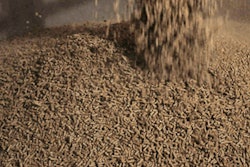
Calcium (Ca) is rarely considered to be a limiting nutrient when formulating diets for pigs. This is largely because it is abundant and relatively inexpensive. Indeed, limestone and calcium carbonate, the two most common sources of calcium worldwide, are readily available and at competitive prices. Yet, there are cases where calcium deficiency or toxicity -- or rather more correctly under- and over-supplementation -- can occur causing considerable problems. We shall examine these in more detail in this article.
The role of calcium
It is widely known that 99 percent of all calcium in the body is found in bones and teeth. Thus, calcium is the most important mineral when it comes to skeletal development and maintenance. Non-skeletal functions, in the form of ionized calcium, include muscle contraction and relaxation, nerve conduction, regulation on blood clotting, and cell signaling in immune responses.
Clearly, calcium is an important nutrient, although not always recognized as such.
Calcium requirements
Calcium requirements range from about 1 percent of complete feed for breeding gilts and sows, down to about 0.5 percent for finishing pigs.
Research on this subject is quite old and unlikely to be updated due to the lack of financial incentives. Several organizations occasionally publish their estimates based mostly on experience and common practice. For example, the British Society of Animal Science in 2002 published a guide on calcium specifications, which is presented in Figure 1, along with more recent estimates from the U.S. National Swine Nutrition Guide (2010).
Calcium deficiency and toxicity
A mild calcium deficiency will cause poor development of the skeletal system resulting in an increased number of “broken backs” at the slaughterhouse (especially in pigs finished at very heavy weights) and poor leg conditions in aged sows. This is certainly a chronic problem caused by improper feed formulation and failure to consider actual feed intake, current performance levels, and other interacting factors, including the feed manufacturing system (for example, the degree of accuracy in weighing ingredients).
A severe deficiency, highly unlikely to occur under modern commercial production practices, is causing rickets (poorly developed bones causing malformation) in growing pigs and osteomalacia (brittle bones) in mature pigs. Such problems can occur when a feed mixing or formulation error happens due to negligence.
Calcium toxicity is very rare and, again, it only occurs by accidental overdose due to a mixing or formulation errors.
Pigs are quite resistant to calcium overdose, but a chronic toxicity will cause internal calcification of organs and growth stasis. Most problems are attributed to reduced absorption of phosphorus and zinc rather than hypercalcemia itself.
Calcium in piglet diets
Calcium carbonate and limestone have a very strong buffering capacity in that they can neutralize hydrochloric acid secreted in the stomach. This acid is the first step in the enzymatic breakdown of proteins and with its suppression, undigested proteins pass on the large intestine where they can be used as food by pathogenic bacteria, such as Salmonella and Collibacteria, causing severe diarrheas. To make matters worst, hydrochloric acid secretion is not fully developed in recently weaned pigs.
To this end, piglet diets should contain only enough calcium to sustain rapid growth, avoiding thus excesses, and in some cases even the traditional margins of safety employed in feed formulation should be omitted. Some early diets may even contain calcium at marginal levels.
Calcium in sow diets
Most diets for developing gilts and breeding sows (gestating, dry and lactating) do not contain adequate calcium. With the major cause of sow culling being leg problems, worldwide, it is logical to assume that sound development of bone structure should be of paramount importance from an early age. Yet, this is rarely the case.
Instead, most developing gilts receive calcium levels suitable for growing-finishing pigs, but clearly inadequate for long-term bone development. As such, they enter the reproductive cycle with a weak or rather under-developed skeleton system. Overfeeding during gestation, a common problem in Spain, offers little in terms of improving bone development at an early age as most gestating diets are usually low in calcium. In addition, fat sows during lactation exhibit poor feed intake causing substantial loss of calcium from the bones, which is very hard to replace as sows age.
Calcium is also involved in the initiation of milk production in recently farrowed sows. Manipulation of calcium supplementation right before and after farrowing has shown to increase milk yield during the first week of lactation.
Calcium is an important mineral at all stages in a pig’s life and attention to the appropriate inclusions should always be taken into consideration.

















